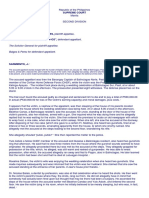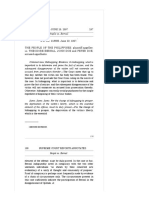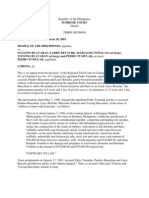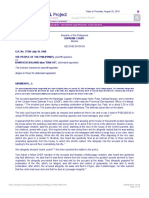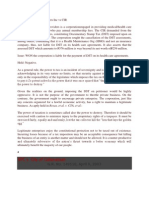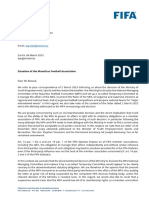People of The Philippines, Appellee, vs. Ronnie Abolidor, Claudio Barcimo, Jr. and Francisco Comoda, Accused. CLAUDIO BARCIMO, JR., Appellant
People of The Philippines, Appellee, vs. Ronnie Abolidor, Claudio Barcimo, Jr. and Francisco Comoda, Accused. CLAUDIO BARCIMO, JR., Appellant
Uploaded by
Irene QuimsonCopyright:
Available Formats
People of The Philippines, Appellee, vs. Ronnie Abolidor, Claudio Barcimo, Jr. and Francisco Comoda, Accused. CLAUDIO BARCIMO, JR., Appellant
People of The Philippines, Appellee, vs. Ronnie Abolidor, Claudio Barcimo, Jr. and Francisco Comoda, Accused. CLAUDIO BARCIMO, JR., Appellant
Uploaded by
Irene QuimsonOriginal Description:
Original Title
Copyright
Available Formats
Share this document
Did you find this document useful?
Is this content inappropriate?
Copyright:
Available Formats
People of The Philippines, Appellee, vs. Ronnie Abolidor, Claudio Barcimo, Jr. and Francisco Comoda, Accused. CLAUDIO BARCIMO, JR., Appellant
People of The Philippines, Appellee, vs. Ronnie Abolidor, Claudio Barcimo, Jr. and Francisco Comoda, Accused. CLAUDIO BARCIMO, JR., Appellant
Uploaded by
Irene QuimsonCopyright:
Available Formats
FIRST DIVISION
[G.R. No. 147231. February 18, 2004]
PEOPLE OF THE PHILIPPINES, appellee, vs. RONNIE ABOLIDOR, CLAUDIO BARCIMO, JR. and FRANCISCO COMODA, accused. CLAUDIO BARCIMO, JR., appellant. DECISION
YNARES-SANTIAGO, J.:
This is an appeal from the decision[1] dated January 31, 2000 of the Regional Trial Court of Iloilo City, Branch 31, in Criminal Case No. 40948, convicting Claudio Barcimo, Jr. @ Noc-noc, Ronnie Abolidor and Francisco Comoda of the crime of murder, sentencing them to suffer the penalty of reclusion perpetua and ordering them to pay P100,000.00 as civil indemnity, P16,000.00 as actual damages and P30,000.00 as moral and exemplary damages. Claudio Barcimo, Jr., Ronnie Abolidor and Francisco Comoda were indicted for Murder in an Information alleging:
That on or about the 14 day of June 1993, in the Municpality of New Lucena, Iloilo, Philippines, and within the jurisdiction of this Honorable Court, the above-named accused conspiring, confederating and helping one another together with another unidentified person, armed with firearms of unknown caliber, with deliberate intent and decided purpose to kill, with treachery, superior strength and evident premeditation, did then and there, willfully, unlawfully and feloniously attack and shoot Thelma Subosa with said firearms hitting the latter on the head, chest and other parts of her body which caused the death of said Thelma Subosa immediately thereafter.
th
CONTRARY TO LAW.
[2]
Upon arraignment,[3] the three accused pleaded not guilty. Trial on the merits ensued. The victim, Thelma Subosa, was the mother of 14 children with her deceased husband, Primo Subosa. Subsequently, she cohabited with her common-law husband Warlito Huesca and lived together with some of her children in Brgy. Janipa-an, Oeste, New Lucena, Ilo-ilo. Thereafter, Warlito Huesca also died.
In the early morning of June 14, 1993, a day after Warlito was buried, the victim, her children namely, Ellyn, Roselyn, Evelyn, Manilyn, Leopoldo and Lilibeth, and Milagros Huesca, the younger sister of Warlito Huesca, were awakened by the forcible opening of the door of their house. Four men entered the house and declared a hold up. The victim pleaded not to be harmed. Instead, accused Ronnie Abolidor tied her mouth with a handkerchief to silence her. Then appellant Claudio Barcimo, Jr. shot the victim several times causing her instantaneous death.[4] Prosecution witnesses Ellyn and Roselyn identified Claudio Barcimo, Jr. and Ronnie Abolidor since they slept on the same mat with the victim and a kerosene lamp was near the victims head.[5] Both testified that they knew Ronnie Abolidor because he was their neighbor for several years, and Claudio Barcimo, Jr. because he was a friend of their deceased stepfather. Francisco Comoda was later identified by the witnesses at the police station.[6] Roselyn also testified that on June 12, 1993, at the burial of their stepfather, the victim told her that it was Claudio Barcimo, Jr. @ Noc-Noc who killed Warlito Huesca.[7] For his part, appellant denied any participation in the killing of Thelma Subosa and claimed that he could not have done it because he was a good friend of Warlito Huesca; that on June 13, 1993, at around 4:00 p.m., he was with Brgy. Capt. Buol in a celebration at the house of Brgy. Capt. Gerardo Paniza at Brgy. Dawis. He had dinner and watched game of mahjong; that at around 10:00 p.m., he went to sleep on the sofa near the mahjong table; that the mahjong game lasted until 4:00 a.m. the following day; that he and Capt. Buol went back to New Lucena at about 6:00 a.m. of June 14, 1993; and on the next day, he left for Manila for treatment of tuberculosis.[8] After trial, the trial court convicted the three accused on January 31, 2000 in a decision, the dispositive portion of which reads:
WHEREFORE, the prosecution having sufficiently established the guilt of all the three accused, namely, Claudio Barcimo, Jr., alias Nocnoc, Ronilo Abolidor alias Ronnie and Francisco Comoda, beyond reasonable doubt (Rule 133, Sec. 2, Revised Rules of Court) of the offense of Murder under Art. 248, R.P.C. as alleged in the Information, this Court hereby renders judgment sentencing all the said accused to suffer the penalty of imprisonment consisting of Reclusion Perpetua, with all the attendant accessory penalties, to pay P100,000.00 as indemnity for death to the heirs of the late Thelma Sobusa, to pay the sum of P16,000.00 as actual damages, and P30,000.00 by way of moral and exemplary damages and to pay the costs. SO ORDERED.
[9]
Only Claudio Barcimo, Jr. appealed the decision raising the following assignment of errors:
A. THE TRIAL COURT ERRED IN RELYING ON THE TESTIMONIES OF PROSECUTION WITNESSES ELLEN SOBUSA AND ROSELYN SOBUSA AND IN NOT APPRECIATING THE TESTIMONY OF THE AUNT OF SAID WINTNESSES
AS CORROBORATED BY THE BARANGAY CAPTAIN OF THE PLACE WHERE THE INCIDENT HAPPENED THAT THE SAID PROSECUTION WITNESSES HAVE NOT IDENTIFIED THE KILLERS. B. THE TRIAL COURT ERRED IN HOLDING THAT TREACHERY IS ATTENDANT IN THE COMMISSION OF THE CRIME. C. THE TRIAL COURT ERRED IN HOLDING THAT NIGHTTIME IS ATTENDANT IN THE COMMISSION OF THE CRIME. D. THE TRIAL COURT ERRED IN NOT APPRECIATING THE VOLUNTARY SURRENDER OF THE ACCUSED.[10]
Appellant Claudio Barcimo, Jr. contends that his identification by Ellyn and Roselyn as one of the assailants is doubtful because when asked whether they know the assailants, they replied in the negative. The contention is without merit. By challenging his identification by the witnesses of the prosecution, as one of the assailants of the victim, the appellant attacks the credibility of said witnesses and the probative weight of their testimonies. However, when the issue of credibility of witnesses is in question, the findings of facts of the trial court, its calibration of the testimonies of witnesses and its assessment of the probative weight thereof, as well as its conclusions anchored on said findings are accorded by the appellate court high respect if not conclusive effect, precisely because of the unique advantage of the trial court in observing and monitoring at close range the demeanor, deportment and conduct of the witnesses as they testify, unless the trial court has overlooked, misconstrued or misinterpreted cogent facts of substance which if considered might affect the result of the case.[11] In the case at bar, there is no showing that the trial court overlooked, misunderstood, misapplied or misconstrued any fact of substance that might materially affect the outcome of the case. The trial court found the collective testimonies of the prosecution witnesses Ellyn and Roselyn to be:
generally impressionable but their natural naivet and inexperience make them reliable witnesses. Their statements are generally free from any bias or prejudice as to be slanted or malicious. It is observed that the testimonies of Ellyn and Roselyn Sobusa are direct, straightforward and delivered without any hesitancy whatsoever.
[12]
The two prosecution witnesses, Ellyn and Roselyn Sobusa, positively identified appellant as the one who shot the victim. Although the incident occurred during nighttime, the house of the victim was sufficiently illuminated by the kerosene lamp placed near the head of the victim, which provided enough light for purposes of identifying the killers. On direct testimony, Ellyn Sobusa narrated the incident as follows:
Q. Can you recall in the morning of June 14, 1993 if there was any unusual incident that happened?
A.
Yes, sir.
Q. What is that incident about? A. At around that time I was awakened by the sound of the opening of the door. I saw four (4) persons entered our house and one them said, This is a hold up. My mother then pleaded, Do not kill me. Have mercy.
Q. What happened after your mother pleaded have mercy? A. There was a shot and I ducked. Then another shot was fired which I do not know anymore because I lied with my face down.
Q. Do you know the person who said this is a hold up? A. Yes, sir.
Q. Who is he? A. Nocnoc.
Q. How far is this Nocnoc when you said he shot your mother? A. Very near.
Q. What was the position of your mother by the time she was shot by Nocnoc? A. She was lying down.
xxx
xxx
xxx
Q. Miss witness, this incident happened at around 2:00 oclock in the morning, why are you sure that Ronnie Abolidor was one of the four persons who entered your house? A. Because we have a kerosene lamp placed very near the head of my mother.
Q. How far is that kerosene lamp from your mother? A. Witness demonstrates about 5 to 6 inches more or less.
Q. At that time that she was shot by Nocnoc, how far is Nocnoc from the kerosene lamp? A. Nocnoc was situated on the feet of my mother.
Q. What was the position of Nocnoc when he shot your mother? A. He was standing.[13]
Considering the illumination from the kerosene lamp, and Ellyns proximity to her mother and to the appellant, she could have clearly seen and recognized the appellant when he shot the victim. In People v. Prieto,[14] we ruled that the illumination provided by kerosene lamp or wicklamps, and flashlights, moonlight or starlight may, in proper situations, be considered as sufficient illumination, making the attack on the credibility of witnesses solely on that ground unmeritorious.
Moreover, Roselyn testified that she was familiar with the voice of the appellant as he was a friend of his stepfather and she visited appellants house several times. [15] The voice of a person is an acceptable means of identification where it is established that the witness and the accused knew each other personally and closely for a number of years. Once a person has gained familiarity with another, identification becomes quite an easy task even from a considerable distance.[16] We also note that appellant did not deny that Warlito Huesca was his good friend and that he visited their house many times.[17] The credibility of the prosecution witnesses Ellyn and Roselyn is not adversely affected by their failure to immediately report the identities of the perpetrators to the responding authorities immediately after the incident. Indubitably, fear stifled the witnesses from voicing their knowledge of the identities of the perpetrators. There is no rule that a witness should immediately name the suspect in a crime.[18] Nevertheless, the delay was not that long as when the police authorities investigated the witnesses in the afternoon of June 14, 1993 at Brgy. Agutayan, Sta. Barbara, Iloilo, they named appellant and accused Ronnie Abolidor as two of the perpetrators.[19] To escape criminal liability, appellant invokes the defense of alibi and denial. He asserts that he could not have done it considering that Warlito Huesca, the common-law husband of the victim, was his good friend and at the time of the incident he was at Brgy. Dawis together with Brgy. Capt. Buol in the house of Brgy. Capt. Gerardo Pineza watching the game of majhong. We are not convinced. It is well settled that positive identification, where categorical and consistent and not attended by any showing of ill motive on the part of the eyewitnesses testifying on the matter, prevails over alibi and denial which, if not substantiated by clear and convincing evidence, are negative and self-serving evidence undeserving weight in law.[20] Hence, the defense of denial and alibi cannot prosper in the light of the positive identification by eyewitnesses Ellyn Sobusa and Roselyn Sobusa that appellant was the one who shot their mother. We agree with the trial courts appreciation of the presence of qualifying circumstance of treachery. There is treachery when the offender commits any of the crimes against persons, employing means, methods, or forms in the execution thereof which tend directly and specially to insure its execution, without risk to himself arising from the defense which the offended party might make. It is settled that there is treachery if the victim, when killed, was sleeping or had just awakened, because in such cases the victim was in no position to put up any form of defense.[21] In the case at bar, the victim had just awakened from sleep because of the forcible opening of their door. When she was shot by appellant, she was lying down on the mat with a handkerchief tied around her mouth. Obviously, in this position she can not defend herself from the aggression of the perpetrators. The trial court did not err in disregarding the mitigating circumstance of voluntary surrender. To benefit an accused, the following requisites must be proven, namely: (1) the offender has not actually been arrested; (2) the offender surrendered himself to a
person in authority; and (3) the surrender was voluntary. A surrender to be voluntary must be spontaneous, showing the intent of the accused to submit himself unconditionally to the authorities, either because he acknowledges his guilt, or he wishes to save them the trouble and expense necessarily incurred in his search and capture. Voluntary surrender presupposes repentance.[22] In People v. Viernes,[23] we held that going to the police station to clear ones name does not show any intent to surrender unconditionally to the authorities. In the case at bar, appellant surrendered to the authorities after more than one year had lapsed since the incident and in order to disclaim responsibility for the killing of the victim. This neither shows repentance or acknowledgment of the crime nor intention to save the government the trouble and expense necessarily incurred in his search and capture. Besides, at the time of his surrender, there was a pending warrant of arrest against him.[24] Hence, he should not be credited with the mitigating circumstance of voluntary surrender. Appellant is guilty of Murder, qualified by treachery, for the killing of Thelma Sobusa. Article 248 of the Revised Penal Code, as amended, imposes the penalty of reclusion perpetua to death for Murder. The trial court was correct in imposing the penalty of reclusion perpetua, there being no aggravating or mitigating circumstance, pursuant to Article 63, paragraph 2 of the Revised Penal Code. The trial court awarded the amount of P100,000.00 as civil indemnity to the heirs of the victim. Said amount must be reduced to P50,000.00, in line with prevailing jurisprudence.[25] The award of actual damages must also be modified. While appellant admitted the amount of P19,000.00 as actual damages,[26] the trial court only awarded the amount of P16,000.00.[27]Ordinarily, receipts should support claims of actual damages, but where the amount claimed was admitted, it should be granted.[28] Consequently, the heirs of the victim is entitled to be awarded the amount of P19,0000.00 as actual damages. The trial court likewise erred when it awarded the amount of P30,000.00 as moral and exemplary damages without indicating what amount constitutes moral damages and exemplary damages. In murder and homicide cases, the award of moral damages should be substantiated by evidence.[29] In the case at bar, the prosecution failed to present proof of moral damages. Therefore, the same should be deleted. On the other hand, exemplary damages must be awarded in view of the attendance of treachery which qualified the killing to Murder. Under Article 2230 of the Civil Code, exemplary damages as part of the civil liability may be imposed when the crime was committed with one or more aggravating circumstances. The term aggravating circumstances as used therein is to be understood in its broad or generic sense since the law did not specify otherwise. The ordinary qualifying nature of an aggravating circumstance is a distinction that should only be of consequence to the criminal, rather than to the civil liability of the offender. Thus, the heirs of the victim are entitled to exemplary damages in the amount of P25,000.00.[30] WHEREFORE, in view of the foregoing, the decision of the Regional Trial Court of Iloilo City, Branch 31, in Criminal Case No. 40948, insofar as it finds Claudio Barcimo,
Jr. @ Noc-noc guilty beyond reasonable doubt of the crime of murder and sentences him to suffer the penalty of reclusion perpetua is AFFIRMED with the MODIFICATION that appellant is ORDERED to pay the heirs of Thelma Sobusa the amounts of P50,000.00 as civil indemnity, P19,000.00 as actual damages and P25,000.00 as exemplary damages. The award of moral damages is DELETED. Costs de oficio. SO ORDERED. Davide, Jr., C.J., (Chairman), Panganiban, Carpio, and Azcuna JJ., concur
[1]
Penned by Judge Rene S. Hortillo. Rollo, p. 10. Accused Ronnie Abolidor and Francisco Comoda were arraigned on August 12, 1993, Records, p. 14; and Appellant Claudio Barcimo on March 23, 1994, Records, p. 111. TSN, September 20, 1993, pp. 8-13. Id., p. 13. TSN, December 16, 1993, pp. 12-13. TSN, April 26, 1994, pp. 8-10. TSN, May 18, 1995, pp. 5-13. Rollo, p. 144. Id., p. 98. People v. Abut, G.R. No. 137601, 24 April 2003. Rollo, Decision, p. 142. TSN, September 20, 1993, pp. 8-13. G.R. No. 141259, 18 July 2003. TSN, April 26 1994, pp. 23-25, 35. People v. Tuppal, G.R. Nos. 137982-85, 13 January 2003. TSN, May 18, 1995, pp. 5-7. People v. Lawa, G.R. Nos. 126147 & 143925-26, 28 January 2003. TSN, April 26, 1994, pp. 17-18. People v. Aliben, G.R. No. 140404, 27 February 2003. People v. Fernandez, G.R. No. 134762, 23 July 2002. Luces v. People, G.R. No. 149492, 20 January 2003. G.R. Nos. 136733-35, 13 December 2001. Records, p. 11.
[2]
[3]
[4]
[5]
[6]
[7]
[8]
[9]
[10]
[11]
[12]
[13]
[14]
[15]
[16]
[17]
[18]
[19]
[20]
[21]
[22]
[23]
[24]
[25]
People v. Delada, G.R. No. 137406, 26 March 2003. TSN, July 22, 1994, p. 4. Rollo, p. 144. Talay v. Court of Appeals, G.R. No. 119477, 27 February 2003. People v. Caballero, G.R. Nos. 149028-30, 2 April 2003. People v. Pidoy, G.R. No. 146696, 3 July 2003.
[26]
[27]
[28]
[29]
[30]
You might also like
- What Is Custodial InvestigationDocument11 pagesWhat Is Custodial InvestigationIrene Quimson100% (4)
- People Vs AbolidorDocument6 pagesPeople Vs AbolidorANALIZA ALCOSERONo ratings yet
- PEOPLE Vs ROLLY ABULENCIADocument11 pagesPEOPLE Vs ROLLY ABULENCIAAina SyNo ratings yet
- People vs. QuimzonDocument21 pagesPeople vs. QuimzonCinja ShidoujiNo ratings yet
- 14 5 C People Vs BalansiDocument4 pages14 5 C People Vs BalansiKing BautistaNo ratings yet
- Case Digests Philo Finals Dec. 9Document5 pagesCase Digests Philo Finals Dec. 9Jacel Anne RequinaNo ratings yet
- 002 People v. Quimzon, G.R. No. 133541, 14 April 2004Document20 pages002 People v. Quimzon, G.R. No. 133541, 14 April 2004John WickNo ratings yet
- G.R. No. 127754Document8 pagesG.R. No. 127754jericglennNo ratings yet
- People Vs Avila Child WitnessDocument6 pagesPeople Vs Avila Child WitnessJomar TenezaNo ratings yet
- GR No. 133541 Corpuz DelicteDocument16 pagesGR No. 133541 Corpuz Delicteanthony dinNo ratings yet
- Evidence Case DigestDocument48 pagesEvidence Case DigestClark InovejasNo ratings yet
- People v. Salufrania G.R. No. 50884Document3 pagesPeople v. Salufrania G.R. No. 50884Ma Christine Montalbo IrlandezNo ratings yet
- People Vs Monje: 146689: September 27, 2002: J. Bellosillo: en BancDocument7 pagesPeople Vs Monje: 146689: September 27, 2002: J. Bellosillo: en BancAliyahDazaSandersNo ratings yet
- Part 2Document253 pagesPart 2Fairyssa Bianca SagotNo ratings yet
- 03-People V BernalDocument10 pages03-People V BernalJesus Angelo DiosanaNo ratings yet
- People vs. Dramayo (G.R. No. L-21325, October 29, 1971)Document7 pagesPeople vs. Dramayo (G.R. No. L-21325, October 29, 1971)AndresNo ratings yet
- People V EstepanoDocument3 pagesPeople V EstepanoMarcie Denise Calimag AranetaNo ratings yet
- People v. Dramayo G.R. No. L-21325Document4 pagesPeople v. Dramayo G.R. No. L-21325Gen GrajoNo ratings yet
- People v. Cagoco, G.R. No. 38511, October 6, 1933Document5 pagesPeople v. Cagoco, G.R. No. 38511, October 6, 1933Mayrll SantosNo ratings yet
- Republic of The Philippines Manila First DivisionDocument4 pagesRepublic of The Philippines Manila First DivisionYappi NaniNo ratings yet
- Cardenas, 56 SCRA 631Document3 pagesCardenas, 56 SCRA 631ANALIZA ALCOSERONo ratings yet
- People v. Ragundiaz 334 SCRA 193Document12 pagesPeople v. Ragundiaz 334 SCRA 193Khristine Ericke De MesaNo ratings yet
- 09 PP V BauyabanDocument13 pages09 PP V BauyabanJay Ryan Sy BaylonNo ratings yet
- People Vs AbulenciaDocument10 pagesPeople Vs Abulenciazatarra_12No ratings yet
- People vs. Alfonso FontanillaDocument6 pagesPeople vs. Alfonso FontanillaLolersNo ratings yet
- People Vs EstepanoDocument5 pagesPeople Vs Estepanonido12No ratings yet
- Crim CasesDocument26 pagesCrim CasesAudrey AlmanonNo ratings yet
- Supreme Court: Benigno P. Pulmano For Petitioner. The Solicitor General For RespondentsDocument7 pagesSupreme Court: Benigno P. Pulmano For Petitioner. The Solicitor General For RespondentsPrince CayabyabNo ratings yet
- En Banc (G.R. No. 126124. January 20, 1999.) PEOPLE OF THE PHILIPPINES, Plaintiff-Appellee, v. ZALDY P. PADILLA, Accused-Appellant. DecisionDocument6 pagesEn Banc (G.R. No. 126124. January 20, 1999.) PEOPLE OF THE PHILIPPINES, Plaintiff-Appellee, v. ZALDY P. PADILLA, Accused-Appellant. DecisionAnne Camille SongNo ratings yet
- CASE DIGEST - GR No. L-50884Document4 pagesCASE DIGEST - GR No. L-50884Juvy CambayaNo ratings yet
- People v. Porferio SosingDocument8 pagesPeople v. Porferio SosingArchelaus Philo KarpusNo ratings yet
- Crim ONe DigestsDocument6 pagesCrim ONe DigestsArdenNo ratings yet
- People of The Philippines, Plaintiff-Appellee, vs. Paulino Sevilleno Y Villanueva Alias TAMAYO, Accused-AppellantDocument5 pagesPeople of The Philippines, Plaintiff-Appellee, vs. Paulino Sevilleno Y Villanueva Alias TAMAYO, Accused-AppellanteenahNo ratings yet
- Alibi As DefenseDocument2 pagesAlibi As DefenseGlutton ArchNo ratings yet
- Crim Uno DigestsDocument6 pagesCrim Uno DigestsArdenNo ratings yet
- G.R. No. 130210. December 08, 1999Document8 pagesG.R. No. 130210. December 08, 1999Adrian GalizaNo ratings yet
- Crim Law Cases FinalsDocument167 pagesCrim Law Cases FinalsAaliyah AndreaNo ratings yet
- People Vs Cagoco, 58 Phil 524 (Praeter Intentionem and Doctrine of Proximate Cause)Document4 pagesPeople Vs Cagoco, 58 Phil 524 (Praeter Intentionem and Doctrine of Proximate Cause)Claudia Rina LapazNo ratings yet
- People Vs DramayoDocument5 pagesPeople Vs DramayomanilatabajondaNo ratings yet
- People V SamusDocument15 pagesPeople V SamusTon Ton CananeaNo ratings yet
- Colinares vs. People of The PhilippinesDocument16 pagesColinares vs. People of The PhilippinesPaul Patrick S. BlancoNo ratings yet
- Crimes Against 33-36Document6 pagesCrimes Against 33-36Ed PadNo ratings yet
- Per Curiam: "Contrary To Law."Document13 pagesPer Curiam: "Contrary To Law."Nathalie BermudezNo ratings yet
- People V Alburo 184 SCRA 655Document10 pagesPeople V Alburo 184 SCRA 655Carissa CruzNo ratings yet
- 622 Csra 417Document17 pages622 Csra 417Jay EmmanuelNo ratings yet
- 15189410-1998-People v. Bibat y DescargarDocument11 pages15189410-1998-People v. Bibat y DescargarChristine Ang CaminadeNo ratings yet
- The People of The Philippines, Plaintiff-Appellee, vs. Bonifacio Balansi Alias "BAN-OS", Defendant-AppellantDocument5 pagesThe People of The Philippines, Plaintiff-Appellee, vs. Bonifacio Balansi Alias "BAN-OS", Defendant-AppellantAAMCNo ratings yet
- People vs. Golimlim 427 SCRA 15 April 02 2004Document12 pagesPeople vs. Golimlim 427 SCRA 15 April 02 2004Dagul JauganNo ratings yet
- Atizado v. PeopleDocument7 pagesAtizado v. PeopleJc IsidroNo ratings yet
- W.A. Caldwell and Sotto and Astilla For Appellant. Office of The Solicitor-General Bengzon For AppelleeDocument4 pagesW.A. Caldwell and Sotto and Astilla For Appellant. Office of The Solicitor-General Bengzon For AppelleeJolessa Mie SalcedoNo ratings yet
- 74 People Vs Operaña, G.R. No. 120546. October 13, 2000Document11 pages74 People Vs Operaña, G.R. No. 120546. October 13, 2000Perry YapNo ratings yet
- G.R. No. 77284Document5 pagesG.R. No. 77284Dianne MiralNo ratings yet
- People Vs DomingDocument4 pagesPeople Vs DomingHestia VestaNo ratings yet
- People v. QuimzonDocument14 pagesPeople v. QuimzonKim Jona Peralta Castillo100% (2)
- Atizado v. PeopleDocument7 pagesAtizado v. Peopleso hee's gfNo ratings yet
- Vs. vs. Accused-Appellant The Solicitor General Felipe S. AbeledaDocument7 pagesVs. vs. Accused-Appellant The Solicitor General Felipe S. AbeledaCinja ShidoujiNo ratings yet
- Case 17 - People v. Cagoco, 58 Phil 524Document3 pagesCase 17 - People v. Cagoco, 58 Phil 524Jo-Al GealonNo ratings yet
- G.R. No. L-3001Document3 pagesG.R. No. L-3001jardenpritingservicesNo ratings yet
- Sacrifices: The Witch Chronicles - Rise Of The Dark Witch High King - Book OneFrom EverandSacrifices: The Witch Chronicles - Rise Of The Dark Witch High King - Book OneNo ratings yet
- Salient Features of Notarial LawDocument5 pagesSalient Features of Notarial LawIrene Quimson100% (2)
- Promissory NoteDocument1 pagePromissory NoteIrene QuimsonNo ratings yet
- Constructive Dismissal - 2016Document9 pagesConstructive Dismissal - 2016Irene Quimson100% (1)
- Executive DepartmentDocument8 pagesExecutive DepartmentIrene QuimsonNo ratings yet
- Second DivisionDocument10 pagesSecond DivisionIrene QuimsonNo ratings yet
- PEDRO G. SISTOZA, Petitioner, vs. ANIANO DESIERTO in His Capacity As Ombudsman, and ELISEO CO, RespondentsDocument6 pagesPEDRO G. SISTOZA, Petitioner, vs. ANIANO DESIERTO in His Capacity As Ombudsman, and ELISEO CO, RespondentsIrene QuimsonNo ratings yet
- Alternative Dispute Resolution: ArbitrationDocument1 pageAlternative Dispute Resolution: ArbitrationIrene QuimsonNo ratings yet
- Mnemonics in Labor Laws and Social LegislationDocument108 pagesMnemonics in Labor Laws and Social LegislationdavaounionNo ratings yet
- Simultaneously With The Commission of The Fraud. Thus, Under Article 315, Paragraph 2 (D) ofDocument2 pagesSimultaneously With The Commission of The Fraud. Thus, Under Article 315, Paragraph 2 (D) ofIrene QuimsonNo ratings yet
- The Expanded Jurisdiction of Cam and JDRDocument5 pagesThe Expanded Jurisdiction of Cam and JDRliljoyNo ratings yet
- Rule 55. Default Default Judgment: Ntering A EfaultDocument1 pageRule 55. Default Default Judgment: Ntering A EfaultIrene QuimsonNo ratings yet
- Obillos Et Al vs. CIR/CA: MoneyDocument2 pagesObillos Et Al vs. CIR/CA: MoneyIrene QuimsonNo ratings yet
- Small Claims Case Made SimpleDocument21 pagesSmall Claims Case Made SimpleIrene QuimsonNo ratings yet
- C. Criterion-Referenced TestDocument6 pagesC. Criterion-Referenced TestIrene QuimsonNo ratings yet
- Xvii. Special Civil ActionsDocument2 pagesXvii. Special Civil ActionsIrene QuimsonNo ratings yet
- Verification / Certification of Non-Forum Shopping Republic of The Philippines) City of Dagupan) S.SDocument1 pageVerification / Certification of Non-Forum Shopping Republic of The Philippines) City of Dagupan) S.SIrene QuimsonNo ratings yet
- Philosophical FoundationsDocument3 pagesPhilosophical FoundationsIrene QuimsonNo ratings yet
- NPC v. City of Cabanatuan: G.R. No. 149110, April 9, 2003Document3 pagesNPC v. City of Cabanatuan: G.R. No. 149110, April 9, 2003Irene QuimsonNo ratings yet
- IDocument5 pagesIIrene Quimson100% (6)
- 971 - 75: Early Years: Wicked Lester Gene Simmons Paul Stanley Epic RecordsDocument3 pages971 - 75: Early Years: Wicked Lester Gene Simmons Paul Stanley Epic RecordsIrene QuimsonNo ratings yet
- Examples From The Web For Kissexpand: Keep It Simple, StupidDocument1 pageExamples From The Web For Kissexpand: Keep It Simple, StupidIrene QuimsonNo ratings yet
- 1975 - 78: Rise To Prominence: Alive!Document2 pages1975 - 78: Rise To Prominence: Alive!Irene QuimsonNo ratings yet
- This Article Is About The American Rock Band. For The South Korean Group, SeeDocument3 pagesThis Article Is About The American Rock Band. For The South Korean Group, SeeIrene QuimsonNo ratings yet
- Case Digest For Prelim2-FulltxtDocument28 pagesCase Digest For Prelim2-FulltxtjunjunNo ratings yet
- Course File IPR - First 3 UnitsDocument73 pagesCourse File IPR - First 3 UnitsSai Kiran0% (1)
- Prohibited Acts - Fines and Penalties - Republic Act 9275 Philippine Clean Water Act of 2004Document4 pagesProhibited Acts - Fines and Penalties - Republic Act 9275 Philippine Clean Water Act of 2004Monaliza LiztsNo ratings yet
- 04-27-15 EditionDocument28 pages04-27-15 EditionSan Mateo Daily JournalNo ratings yet
- Fortis Vs Gutierrez Hermanos 6 Phil 100Document3 pagesFortis Vs Gutierrez Hermanos 6 Phil 100krisninNo ratings yet
- Nature of ConstitutionDocument6 pagesNature of ConstitutionAnkitTiwariNo ratings yet
- Corporation vs. PartnershipDocument4 pagesCorporation vs. PartnershipPau Che100% (1)
- 19.1abuse of Rights DoctrineDocument2 pages19.1abuse of Rights Doctrinecertiorari19No ratings yet
- YS Muslim Law Notes - 240701 - 231008Document114 pagesYS Muslim Law Notes - 240701 - 231008santoshkumarharti4009No ratings yet
- People v. NarvaezDocument4 pagesPeople v. NarvaezAlfonso Miguel DimlaNo ratings yet
- Final Exam (ObliCon)Document2 pagesFinal Exam (ObliCon)almors100% (2)
- United Nations Counter-Terrorism Centre Summary of Discussions (2013)Document30 pagesUnited Nations Counter-Terrorism Centre Summary of Discussions (2013)Richard J. Campbell https://twitter.com/No ratings yet
- Negotiating EU Trade Agreements: Who Does What and How We Reach A Final DealDocument8 pagesNegotiating EU Trade Agreements: Who Does What and How We Reach A Final DealajukucingNo ratings yet
- FIFA To MFA - Temporary CommitteeDocument2 pagesFIFA To MFA - Temporary CommitteeFabrice FlochNo ratings yet
- Ace Promotion and Marketing Corporation Vs Reynaldo Ursabia G.R. No. 171703 - September 22, 2006 First Division - Ynares-Santiago, JDocument2 pagesAce Promotion and Marketing Corporation Vs Reynaldo Ursabia G.R. No. 171703 - September 22, 2006 First Division - Ynares-Santiago, JTiff DizonNo ratings yet
- Villas at Parkside Partners v. Farmers Branch (5th Cir. 2013) (En Banc)Document122 pagesVillas at Parkside Partners v. Farmers Branch (5th Cir. 2013) (En Banc)J CoxNo ratings yet
- Royal Commission Into Institutional Responses To Child Abuse, Transcript, Day 104Document125 pagesRoyal Commission Into Institutional Responses To Child Abuse, Transcript, Day 104Matthew RemskiNo ratings yet
- 14 Sps Zalamea vs. Court of AppealsDocument2 pages14 Sps Zalamea vs. Court of AppealsJeah N MelocotonesNo ratings yet
- Notes On Police (Powerpoint) Updated VersionDocument34 pagesNotes On Police (Powerpoint) Updated VersionAmira SyaNo ratings yet
- Barresi The Chinese Legal Tradition As Cultural Constraint On Envtl LawDocument50 pagesBarresi The Chinese Legal Tradition As Cultural Constraint On Envtl Lawjohnv.nelson2No ratings yet
- The Australian Partner Visa Guide 4th Ed - SAMPLE - 2021Document21 pagesThe Australian Partner Visa Guide 4th Ed - SAMPLE - 2021Margareta HaryonoNo ratings yet
- Document 109Document12 pagesDocument 109TradconNo ratings yet
- Social Justice Society VS Dangerous Drugs BoardDocument3 pagesSocial Justice Society VS Dangerous Drugs BoardChristian Nero BeltranNo ratings yet
- Passages For USP Challenge MicroorganismsDocument1 pagePassages For USP Challenge Microorganismshoria96No ratings yet
- Bread and Fairs: Book Chapter Bread and Fairs: Broadsheet Printing For The Municipality of Lyon, 1497-1570Document27 pagesBread and Fairs: Book Chapter Bread and Fairs: Broadsheet Printing For The Municipality of Lyon, 1497-1570555-86405No ratings yet
- JBL REYES - Lega EthicsDocument3 pagesJBL REYES - Lega EthicsPeter Carlo DavidNo ratings yet
- Garland V GarlandDocument8 pagesGarland V GarlandwstNo ratings yet
- Aboitiz V CADocument8 pagesAboitiz V CAPrincess AyomaNo ratings yet
- Salvador vs. Sta. MariaDocument2 pagesSalvador vs. Sta. MariaKaye MendozaNo ratings yet
- Business Law Course Outline Lecture 2014Document7 pagesBusiness Law Course Outline Lecture 2014Zwelithini MtsamaiNo ratings yet




